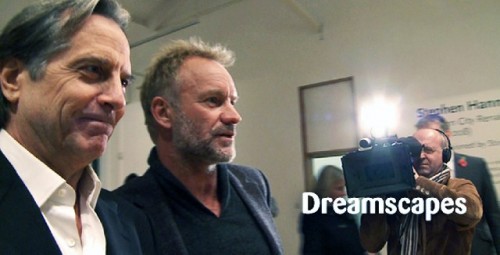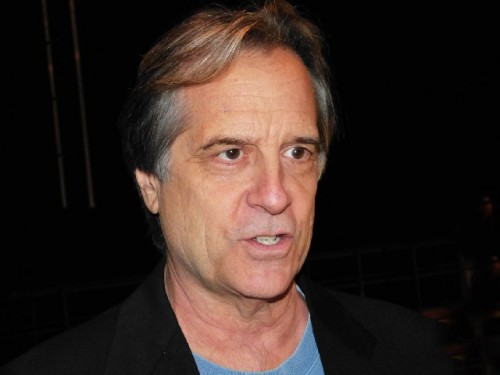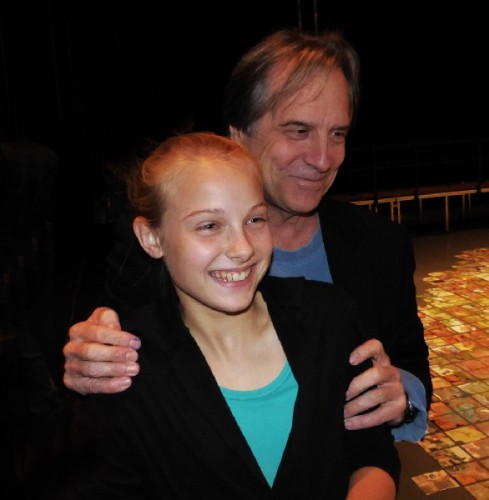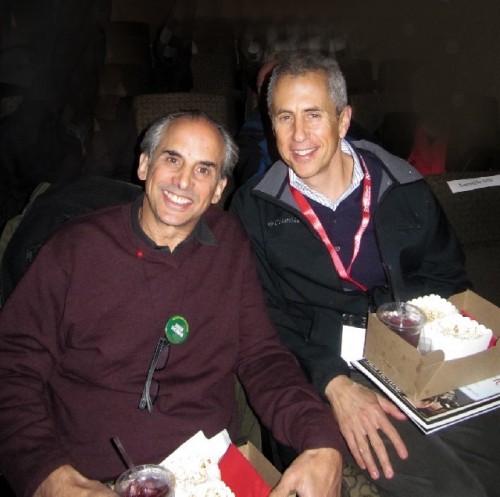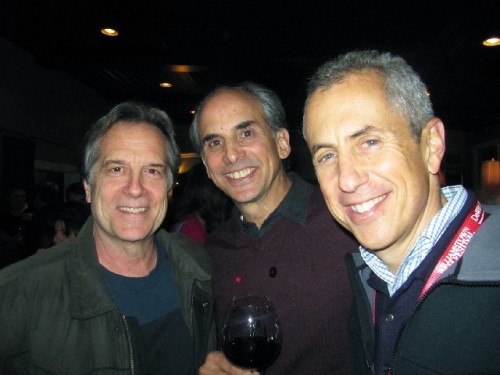Dreamscapes: Stephen Hannock Film by Wolfram Hissen
Williamstown Film Festival Celebration with Top Chef Tom Colicchio
By: Charles Giuliano and Stephen Hannock - Oct 13, 2012
Dreamscapes
Director, Wolfram Hissen
Producer(s), estWest films
Editor, Wolfram Hissen
Director of Photography, Wolfram Hissen
Composer, Sting
Primary Cast: Stephen Hannock, Gary Tinterow, Sting and Trudie Styler, Tom Colicchio, William Lauder
37 minutes
Williamstown Film Festival
October 18, 2012
The Berkshire based, internationally renowned, landscape with text artist, Stephen Hannock, is the subject of a documentary film Dreamscapes by Wolfram Hissen. The filmmaker is known for a long association with the project/ installation artists Christo and his late wife Jeanne Claude.
Using cost effective video equipment Hissen shadowed Hannock at work in the studio, at home with his daughter Georgia, during an opening at New York’s Marlborough Gallery, and on the road in Newcastle, England unveiling a portrait of the city commissioned as a gift by its native son, the musician Sting.
The short documentary also focuses on his unique commissions for the upscale, New York restaurants of entrepreneur, Danny Meyer, and his associate, Tom Colicchio, who created the TV show Top Chef and is its primary judge.
A sold out screening of the film will be shown at Images Cinema during the fourteenth annual Williamstown Film Festival on Thursday, October 18. It will be followed by a tasting party of Coliccio’s food, and a discussion between the artist and chef, at the restaurant Mezze.
In a warren of studio spaces we caught up with Hannock to discuss the film as well as current projects. Last year he showed four, epic scaled paintings earmarked for major museums, at the prestigious Marlborough Gallery. For the first time in decades he is not scheduled for an exhibition this year. He is seizing the opportunity, during spring, to tour for three weeks with his buddy, Sting, who will perform gigs in India.
Recently, he closed the New York studio and is now based full time in the Berkshires. He has a regular schedule in the studio often taking years to develop and complete paintings. While traveling frequently, including an annual “retreat” at Sting’s Italian villa, this also allows for location studies that result in paintings. He has an “idea” for Istanbul.
With major works that now command as much as seven figures he is on the A List of top artists. While many artists on that level run large studios, with numerous assistants that produce the work, Hannock is insistent in pointing out that he is the sole creator of his limited output. The work is hand made, labor intensive, scarce, and avidly pursued by collectors and museums.
Two of his paintings hang in the Metropolitan Museum of Art. His works are regularly viewed in a more elite setting by the handful of New Yorkers who dine in several Michelin starred restaurants.
None of this success has gone to his head. Stephen remains down to earth, charming, witty, and totally open in the many dialogues we have had about his work. It has been some time since I last visited the studio.
As usual, I found him at work putting the finishing touches on the envelope-sized, palimpsests which he creates as the annual Reeve Award for the top film in the annual WFF.
It was actually an envelope that proved to be key to the approach that led to his unique style and its enormous success. He explained that years ago he used old envelopes to sop up the oily surface of his paintings (deKooning used sheets of newspapers). Usually he tossed them in the waste basket. But one missed. When he picked it up and looked at it the besmirched envelope proved to be “more interesting than what I was painting.” There were many fascinating elements bleeding through. It had been used so there was an address to the recipient as well as a return address from the sender and a stamp. The envelope signified a history and narrative below the random layer of blotted paint.
That eventually led to a complex process involving glued on collage elements, and lines of written text, built up in layers over a vedute. The paintings not only created a simulacrum of a site but also its uniquely embedded, often stream of consciousness, narrative. Increasingly, collectors, critics and curators have come to regard his approach as a significant change in landscape painting.
“Some critics have stated that I have ruined the paintings by writing on them” he said.
In the chaos of contemporary art he has largely been ignored by critics and curators. While the work hangs in the Met he has never been included in a Whitney Biennial or on the global Biennial circuit. There have been no features in the major art magazines.
He has a good friend, however, in Joe Thompson and Mass MoCA. So much so that Hannock numbers his paintings as Mass Moca 1, 2, 3, 4 etc. He comments that it is similar to how the Abstract Expressionists often titled and inventoried their paintings based on their studio address.
Joining the mega gallery Marlborough has been a game changer. While he takes a smaller cut than with prior galleries they cover all aspects of creating the work including, materials, building stretchers, crates and frames, shipping, administration, marketing, and sales. He has assistants to run the day to day operations freeing him to focus on the work. It has also changed his approach to outreach.
While he is not scheduled for a gallery exhibition this year he is creating works for the art fairs he never previously participated in. There is one work in progress for the New York Armory Show and another slated for Basel Miami.
When I started to photograph Stephen I discovered a dead battery in my spiffy new camera. David Lachman, who works with Stephen, graciously took pictures and sent me home with a disc for this report.
Fortunately, the recorder was fully charged and this is the first segment of our hour long, on the record, dialogue.
Charles Giuliano I am looking at two large drawings one of which is the Flatiron Building in New York and the other a view of a park. Is this a change in the work from landscapes to cityscapes?
Stephen Hannock That’s Madison Square Park and Bridget's Garden which the city built in honor of my wife. She was a key person in the restoration of Madison Square Park.
(Bridget Watkins Hannock died in 2004 at the age of 40. Their daughter Georgia is 12.)
She was one of the point people for raising the money to have the restoration done. When (restaurateur) Danny Meyer bought the property which became 11 Madison Park it was a shooting gallery. Madison Square Park was a pit. He said we have to clean it up and Bridget (who worked for Meyer) said we have to do this and this. It snowballed much the way the High Line resembles what she did with Madison Square Park.
CG What was her background for that?
SH Nothing. She was Danny’s assistant and PR director. Danny and Tom Colicchio. He’s the chef. He’s the big boy. They started Gramercy Tavern (42 East 20th Street). Now he runs Craft (47 East 19th Street) and Colicchio and Sons (85 Tenth Avenue). He’s the lead judge and producer of Top Chef. He has a big presence in this movie.
What most people miss is that when I was having my first show in the big leagues (Salander and O’Reilly) they were starting Gramercy Tavern. He brought Danny up to see my work.
They made a break from tradition. The best restaurants would finish the space and then put art on the walls. They put me together with the architect before the space was even designed. These are the most recent works and they will go in 11 Madison. I have large paintings there already but we’re skipping twenty years so let’s back track a bit.
I’ve been working with the architect Peter Bentel on every space. When Danny went to make Blue Smoke and 11 Madison Park Tom went on to make Craft. He won the James Beard Award for Craft. It has to do with designing food in its simplest form. Just a little olive oil and you prepare it with the finest ingredients. It’s sensational.
Each of these spaces required different work. That’s what Peter and I would be doing. We have done a dozen spaces so far. When we were doing 11 Madison Park Danny took me over to the foundation of the Met Life building. It’s like a giant, thirty story bunker. It was going to be 149 stories. That was 1929. What happened in 1929? There was an economic meltdown. So they stopped it right there. Danny actually opened two restaurants at the same time.
CG Meyer was featured in the film The Restaurateur by Roger Sherman that was screened during WFF last year.
SH There was a still of our wedding in that film. Bridget and I met when Danny was showing me the space. I had talked with her on the phone for a year or so. When he brought me to see the space he asked if his assistant could come along. She was just gliding all over. Of course I didn’t hear a word he was saying.
I did two 25 foot paintings for the restaurant. And we got married in that space.
CG (Looking at the drawings pinned to the studio wall) Is there going to be text on these?
SH There already is. I finished them last month. The kids who were running 11 Madison Park, Chef Daniel Humm and General Manager Will Guidara, bought it from Danny. Doing three star (Michelin) or four star (New York Times) restaurants is not what Danny wants to do but it’s what they were striving for. They wanted to redo the restaurant and asked for these new paintings. What you can’t tell from the drawings is that they were all ground in reverse. I have an iridescent white paint on the foundation. That’s sealed. Then I painted different grays in layers which I ground down with power tools to get the illuminations. You don’t see any brush strokes. It’s all scraping and grinding. This one “Bridget's Garden” has text. There’s a sign there which tells the story.
CG And the “Flatiron Building.” You’re going from landscape to cityscape.
SH It’s not that so much as its set design for a given play or story. You set the stage for whatever is going on. Like this new painting (walking toward it at the other end of the studio.)
CG Oh my you have chairs now and a sofa!
SH In one of your articles you described the studio as a gym with me and Dave running around. I brought the sofa up from the studio in New York which I have closed after 25 years. It was a pit and costing a fortune to maintain. The rent was going up again. If the service was better I might have stayed. It had no running water.
David Lachman No windows.
SH You couldn’t open the windows they blew out into the street during a storm. They were completely rotted through. It was a huge loft space right at the intersection of Houston and Broadway. It was just a shambles and now the guys have to fix it up. They can’t rent it. Nobody is going to pay ten grand a month or whatever they ask. I was paying close to that.
This painting is “Valley Vineyard with Clearing Fog.” It’s the Napa Valley. What I loved about the patterns in the Valley is that they always reminded me of Diebenkorn. (Richard Diebenkorn, April 22, 1922 – March 30, 1993) And Thiebaud paintings. (Wayne Thiebaud, born November 15, 1920) This is called “Valley for Thiebaud and Diebenkorn.”
I’m about to put the text on but if you come on up here I can show you the underpainting. We glue in the collage elements. These are both paintings of Diebenkorn’s. Here’s a painting of Thiebaud’s here’s another of Thiebaud’s. This is a piece of Martin Puryear’s. He’s a terrific sculptor who did a piece for Steve Oliver’s ranch which is just over the Valley in Sonoma. This is Christopher Brown who I think is a terrific painter. He’s the heir to the Bay Area Painters. This is actually The Oxbow School. When I was doing that piece with (Robert) Redford he was the one who turned me on to The Oxbow School which is a bend in the Napa River. It’s the only boarding art school for high school kids in the country.
(The Oxbow School is a private, single semester arts school for high school juniors and seniors located in Napa, California, sitting near an oxbow of the Napa River.)
They come from all over the country to study art intensely for one semester and then go back to their high school with credits. That was set up by Jock Reynolds and Ann Hatch. They were friends at Phillips Academy in Andover.
So now I am going to tell some of these stories. This is actually Diebenkorn’s studio.

